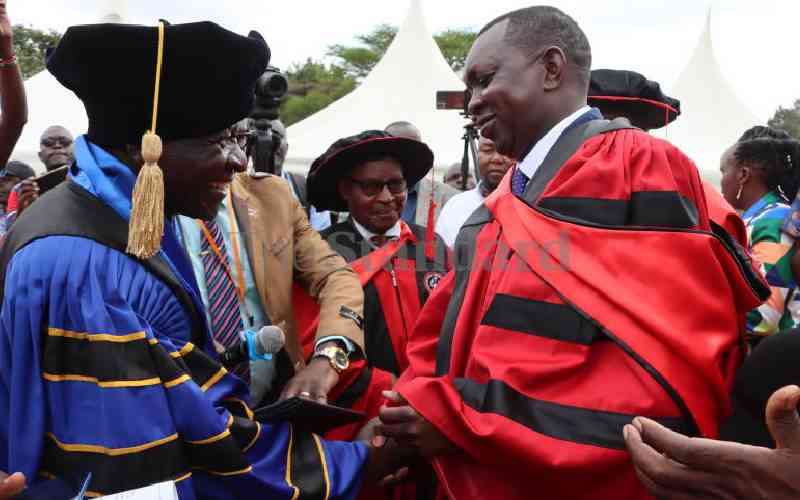 |
|
Water Box innovation by students. PHOTOS: MARY MWENDWA |
Students living in water stressed areas of Kenya are using a simple innovation to plant trees using minimal water. Through a technology known as water box, they are turning their dry and sun-scorched environment green.
The use of the water box innovation comes at a time when the country need to increase its forest cover to the global required minimum of 10 per cent. Inadequate rains and lack of readily available water in arid areas have been a stumbling block in afforestation. Now the water box idea is likely to change all this.
One of the climate change mitigation measures is to increase forest cover through planting trees. Unfortunately, the erratic rainfall patterns experienced in dry areas of Kenya make it difficult to plant and nurture trees.
The box, invented by the Wildlife Clubs of Kenya in partnership with the Worldlife Foundation, works in a simple way. It is filled with 50 mililitres of water then placed on the planted seeds or seedlings.
The water box drains the 50 mililitres of water in a day into the ground. The little water released per day is enough to enable the seed or seedling to source ground water. It also ensures sustainable use of the water for a longer period and does away with the need to water seedlings.
One of the outstanding merits of using the water box is its lifespan, which ensures value.
“You can use it over and over again for at least ten years. Depending on the quality of the soil and temperature, you can use it at least three times a year,” says Margrethe Van Heeswijk of Worldlife Foundation.
Schools in some areas of the Rift Valley have already been trained and offered water boxes for use. In Naivasha, for example, the inventors have linked up with the Elsamere Study Centre in implementing the water box initiative in schools such as Ndabibi, Mirera, Sher Moi, Lake View and Naivasha Boarding primary schools.
Grace Wambui, a pupil at Ndabibi primary school says, “We are happy with this innovation. Our school is now green and we also hope to replicate the same idea in our homes.”
Some 10,000 students and 300 teachers have been directly and indirectly impacted by the project.
So far, the project has seen 3,100 seedlings planted using the technology, says Linah Wodera the Water Box Project Officer Naivasha.
Wodera points out that one of the main challenges facing conservation in Kenya has been the loss of wildlife habitats through deforestation. Therefore, planting of more trees, especially the indigenous variety, can help restore degraded wild lands and open up space for wildlife, which is a prerequisite for the growth of Kenya’s tourism industry.
Tree cover will also provide good aesthetics and boost the ecosystem in communities.
Involving schools equips them with conservation skills and also inculcates environmental responsibility values, making them responsible parents in future.
One of the main causes of climate change is the emission of greenhouse gases, especially global emissions of carbon dioxide. Adverse impacts of climate change in Kenya are caused by unreliable rainfall patterns, rising temperatures and extreme weather events that lead to disasters like drought and floods.
Stay informed. Subscribe to our newsletter
The effects of climate change can now be felt in Kenya’s economy, society and the environment; a large percentage of Kenyans practice rain fed agriculture and therefore changing rainfall patterns have resulted in food insecurity.
This innovation will help mitigate these effects.
 The Standard Group Plc is a
multi-media organization with investments in media platforms spanning newspaper
print operations, television, radio broadcasting, digital and online services. The
Standard Group is recognized as a leading multi-media house in Kenya with a key
influence in matters of national and international interest.
The Standard Group Plc is a
multi-media organization with investments in media platforms spanning newspaper
print operations, television, radio broadcasting, digital and online services. The
Standard Group is recognized as a leading multi-media house in Kenya with a key
influence in matters of national and international interest.
 The Standard Group Plc is a
multi-media organization with investments in media platforms spanning newspaper
print operations, television, radio broadcasting, digital and online services. The
Standard Group is recognized as a leading multi-media house in Kenya with a key
influence in matters of national and international interest.
The Standard Group Plc is a
multi-media organization with investments in media platforms spanning newspaper
print operations, television, radio broadcasting, digital and online services. The
Standard Group is recognized as a leading multi-media house in Kenya with a key
influence in matters of national and international interest.







